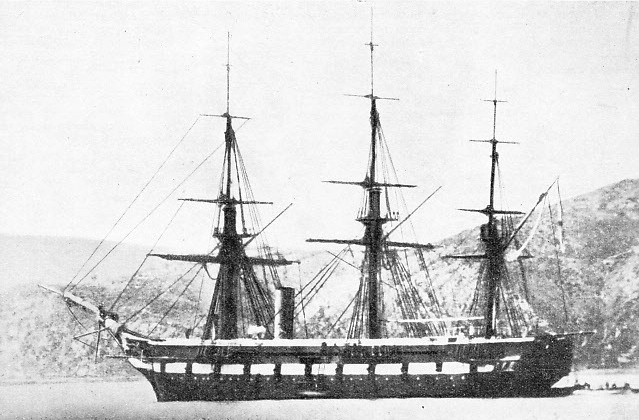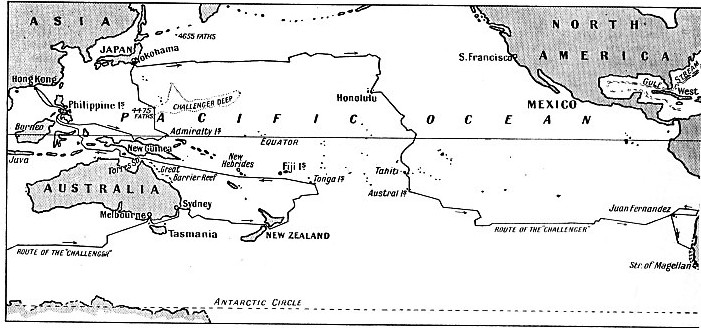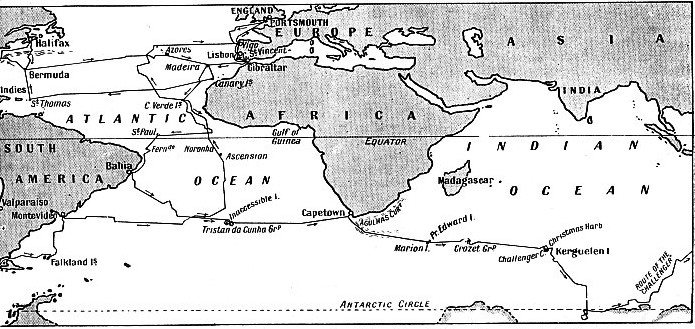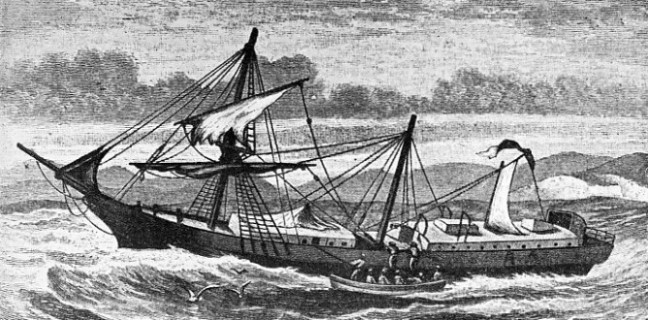

© Shipping Wonders of the World 2012-

Exploring the Ocean Depths
During a voyage that circumnavigated the world in 1872-

THE FAMOUS OLD SURVEY SHIP which laid the foundations for the study of world oceanography. H.M.S. Challenger was a steam corvette, with a displacement of 2,306 tons. She was built at Chatham, Kent, in 1853. A wooden ship with a spar deck. H.M.S. Challenger had three masts and one funnel. Her horizontal direct-
FOR four hundred years ships have penetrated to every corner of the Seven Seas. Few large areas of the ocean’s surface have been left uncharted, except perhaps in the icebound Polar regions; but it is fewer than a hundred years since the first discoveries were made of the ocean depths and of life below the surface of the sea.
The science of oceanography is one of the newest of the sciences. Its importance dates from the amazing voyage of H.M.S. Challenger in 1872-
Captain James Cook and Sir James Clark Ross were the forerunners of the Challenger expedition, and deep-
A number of minor expeditions aroused the general interest in oceanography that led to the commission of the Challenger expedition. The laying of cables along the sea-
The Royal Society was mainly responsible for the scientific research which was in progress in the middle of the nineteenth century. In 1868 the Admiralty placed H.M.S. Lightning at the Society’s disposal for about six weeks. Little could be done in so short a time, but dredgings were made to a depth of 650 fathoms (3,900 feet), a depth never before attained.
During the following two years, further experiments were made, from H.M.S. Porcupine. Depths incomparably greater were reached and the scientific world was astounded. Off the south-
Such revelations created a great enthusiasm for more knowledge. It was as if a new world had been discovered. No one could tell what wonders might be found in the unexplored depths of the ocean. The Royal Society planned a scientific expedition on a large scale. It suggested that the Government should equip a vessel to make a cruise of three or four years’ duration, so that the ocean could be thoroughly and methodically explored.
Thus in a single voyage of four years the whole basis for the study of a new science, oceanography, was laid down. Elaborate preparations were made for the expedition to start in 1872 and the Admiralty offered a suitable vessel — H.M.S Challenger.
The Challenger was a spar-
To equip her for her scientific duties, considerable structural alterations were necessary. All but two of the 64-
Farther forward there was a laboratory fully equipped for analysing and testing samples of sea-
Many devices were evolved for preventing the retorts, thermometers, hydrometers and other equipment from being damaged by the rolling of the ship. Facing the laboratory were a darkroom and another laboratory for photographic purposes, and adjacent was an aquarium for the preservation of any new specimens of fish that might be found on the voyage.
On the upper deck was installed an 18 horse-
“Venus's Flower-
All this work was carried out at Sheerness, Kent, and finally, on November 15, 1872, H.M.S. Challenger was put into commission for a voyage of scientific exploration which was to circumnavigate the globe and provide the world with a comprehensive basis for further oceanographical research in all its branches.
On December 7 the Challenger was swung to adjust her many compasses, and the ship left for Portsmouth. After a stormy passage, she arrived there on December 11.
The boat equipment of the Challenger included a steam pinnace 39 feet long, a barge 29 feet long, two cutters, a dinghy and three whalers. The cutters were hoisted to davits abreast the mizen-
Supplies were shipped and the Challenger’s staff joined her. Captain (later Sir) George Nares, R.N., was in command. He was assisted by officers specially selected by the Admiralty. A spacious chart-
On December 21, 1872, the most important oceanographic expedition the world had known left Portsmouth. Bad weather prevented any soundings from being taken for nine days. Then the first sounding was made forty miles west of Vigo, Spain. The depth was 1,125 fathoms. Dredging operations met with little success, for one dredge fouled the bottom, the rope parted and 9,000 feet of rope were lost.
The Challenger put in at Lisbon, Portugal, and there King Luiz I visited the ship. More than three centuries earlier Lisbon had been the centre of the maritime world. Hence Diaz and da Gama had set out on voyages which had opened up new worlds. Here Columbus had returned after his discovery of the new hemisphere. The visit to Lisbon must have fired the imaginations of the members of the Challenger expedition.
The expedition left Lisbon on January 12, 1873. Off Cape St. Vincent the first strange new denizens of the deep were brought to the surface. Weird fish were found with their eyes bulging out of their heads. Starfish and delicate zoophytes were entangled in the nets and shone with a vivid phosphorescent light. An object never before known except in Japan and the Philippine Islands was discovered here. It is known as “glass-

THE VOYAGE OF H.M.S. CHALLENGER occupied three and a half years. She left Portsmouth on December 21, 1872, and first crossed the Atlantic from the Canary Islands to St. Thomas, Virgin Islands, returning via Bermuda to Madeira. Thence the South Atlantic was explored. Soundings were taken at frequent intervals, and for the first time in history the sea-

From Lisbon to Gibraltar, from Gibraltar to Madeira and Tenerife, the expedition followed its allotted course, taking soundings and using dredges or trawls whenever possible. A daily routine had been drawn up by the Admiralty before the Challenger had sailed, and as far as possible this was adhered to.
The exploration of the Atlantic was the next thing to be done. Following approximately the course that Columbus had taken, the Challenger was to explore, not the, surface, but the bed of the ocean. For the first 250 miles the sea-
Then a remarkable discovery was made. As the depth increased the character of the sea-
Rivers bring down a large amount of silt and mud which is often washed out to sea for tremendous distances. The Congo, for instance, carries mud 600 miles out to sea, and the mud from the Indus and Ganges is found 1,000 miles away from the shore. This deposit contains a certain amount of vegetable and animal matter from the land and covers the sea-
At a depth of 2,000 fathoms approximately, the Challenger expedition found that the ocean floor was almost uniformly covered with what is called ooze. Ooze is formed of mud and the microscopic skeletons of deep-
Trawling at 3,000 Fathoms
Soundings cannot be successfully taken from a ship under sail, because only steam or other power enables a vessel to remain almost stationary in the water. Although the Challenger often relied on her canvas, all sails were furled before sounding operations began. The lines were marked in lengths of 25 fathoms and these were noted as the lines went over the side. The deepest sounding that the Challenger made took a period of nearly three hours from start to finish.
Trawling at a depth of 3,000 fathoms would occupy about thirteen hours. The trawls used in the Challenger varied in width from 10 to 17 feet, but in the Michael Sars expedition of 1910 trawls as much as 50 feet wide were used.
The methods of sounding used in the Challenger were similar in principle to those used to-
To the line were attached the deep-
During the Atlantic crossing the appliances were in constant use. The Challenger reached St. Thomas, one of the Virgin Islands, on February 16, 1873. Here some time was spent in valuable research work and in refuelling the vessel.
Fifteen miles off St. Thomas the Challenger assisted a ship in distress. She was an iron ship of 1,300 tons, the Varuna of Liverpool. She had left New York in January, and storms had brought down her main and mizen masts and carried away most of her canvas. She had been abandoned, but a prize crew from another vessel, the Roundtree, later jury-
In addition to the risks from storms at sea, the Challenger found that even the apparatus she carried was a source of danger. Shortly after she left for Bermuda this danger was brought home only too strongly. A rope span that secured the iron leading block for the dredge-

A SHIP IN DISTRESS was reported to the Challenger at St. Thomas, in the Virgin Islands. The Challenger put out to her assistance. She proved to be the Varuna of Liverpool, an iron vessel of 1,300 tons. Gales had brought down her main and mizen masts and she had been abandoned. She was boarded by a prize crew who tried to sail her to St. Thomas under a jury rig. This illustration shows a boat from the Challenger bringing help to the Varuna.
Between St. Thomas and Bermuda two valuable thermometers were shattered to pieces by “implosion” at a depth of 3,875 fathoms. The pressure of the water was so great that the unprotected tubes and bulbs burst inwards.
From Bermuda the Challenger sailed to Halifax, Nova Scotia, and thus crossed the Gulf Stream. It was found that this current travelled at a rate of about forty miles a day and was about sixty miles wide. Its width was proved by the temperature of the water, which was about 8° higher than in the rest of the ocean.
Another section across the Atlantic was taken from Bermuda to the Azores and from the Azores to Madeira. A course was set for the Gulf of Guinea, but the south-
The Challenger steamed towards the rocks, but when she was only a cable’s length from the shore a rock was seen only a few feet below the surface. The obstacle was avoided and the vessel was secured to a rock on the shore by a hawser. The bows of the Challenger, thus moored to the rocks, were discovered to be in 104 fathoms of water.
Voluntary Exiles
The track of the Challenger plotted on a chart would confuse even the most gifted map-
From St. Paul Rocks she headed for the barren island of Fernando Noronha, at that time used as a penal settlement by the Brazilian Government. After having refuelled at Bahia, Brazil, the Challenger set a course for Capetown. On the way she touched at the desolate Tristan da Cunha group and picked up two Germans who had voluntarily exiled themselves on Inaccessible Island, but who were in the extremes of distress after two years.
On December 17, 1873, the Challenger started on her amazing Antarctic cruise. Interesting information was compiled about the Agulhas Current, a warm stream from the Indian Ocean which sweeps round the south of the African continent until the colder waters of the Atlantic divert it southwards. The contrast in the temperature of the two seas is remarkable. In Table Bay the temperature of the water is 10° lower than in Simon’s Bay, only thirty miles farther south.
The Challenger touched at Prince Edward and Marion Islands and at the Crozet group. Early in January 1874 she reached Kerguelen Island. Nearly 100 years before Cook had anchored here in Christmas Harbour, and Ross had spent sixty-
This task the expedition took in its stride, naming the southern extremity of the island Cape Challenger. A number of American ships were engaged in seal and whale fishing off Kerguelen. At the time of the Challenger’s visit there were two schooners, the Roswell King and the Charles Coldgate. The barque Roman sailed between America and Kerguelen every year with supplies.
On February 1, the Challenger left Kerguelen. Before long came the first encounter with the icebergs, and soon the Challenger was making her way through the ice-
It was only thirty years since Ross had penetrated to the Great Ice Barrier, and the officers in the Challenger were doubtful of the existence of any Antarctic Continent. They were within fifteen miles of the position where, in 1840, the United States explorer, Lieutenant Wilkes, claimed to have discovered this continent; but no land was visible on a clear horizon, and it was impracticable to advance farther.
The dangers of navigation in the ice were soon to become evident. The Challenger came into collision with a large iceberg which carried away her jib-
The sea was studded with large icebergs which threatened to smash the little ship at any moment. Suddenly a great mass of ice would loom up, and only by straining her engines at full speed astern could the Challenger get clear in time.
The expedition arrived safely at Melbourne, Victoria, on April 1, 1874. The remainder of the year was spent in Australasian and Oriental waters. The sea-
This is still probably the most treacherous portion of any ocean. From a depth of as much as 2,000 fathoms great coral reefs rise sheer from the ocean bed sometimes to a height of only 10 feet above sea level. The Royal Australian Navy now has one ship, the Moresby, engaged solely in surveying and charting these perilous seas.
During the latter half of 1874 the Challenger cruised in Asiatic waters. At Hong Kong, Captain Nares received a telegram from the Admiralty appointing him to command the forthcoming Arctic Expedition, and he left the ship in command of Captain F. T. Thomson, from H.M.S. Modeste, then stationed at Hong Kong.
4,475 Fathoms
The first part of 1875 was occupied by a cruise to the Philippine Islands, New Guinea and the Admiralty Islands, where a harbour was named after Captain Nares. On March 23 the deepest sounding of the whole voyage was taken. The lead struck the bottom at a depth of 4,475 fathoms (26,850 feet) in lat. 11° 24' N. and long. 143° 16' E. Greater depths have since been discovered in the Pacific, and if Mount Everest were to be placed on the ocean bed in certain parts, water would cover the peak to a depth of more than 3,000 feet. Two months were spent in Japan before the Challenger set sail for Honolulu. In 1874 the United States had sent the Tuscarora to take soundings between Yokohama and San Francisco, with a view to establishing telegraphic communication. She claimed to have sounded to a depth of 4,655 fathoms. The Challenger, however, took a different course and sounded no deeper than 3,000 fathoms in this section.
The Challenger called at Valparaiso, Chile, and when she had passed through the Strait of Magellan her voyage was nearly at an end. Between the Falkland Islands and Montevideo, Uruguay, a curious phenomenon was recorded on February 11. The thermometers suddenly showed a temperature of 32 Fahrenheit at a depth of 2,040 fathoms, although the surface temperature was 76°. This amazing divergence is caused by a cold current from the Antarctic which sweeps up the South American coast almost as far north as the Equator and returns by the African coast to Antarctic waters, remaining at a depth of about 2,000 fathoms all the time.
Finally, the Challenger anchored off Portsmouth on May 24, 1876. She had been away from home for nearly four years and had covered a distance of more than 68,000 miles. The expedition had been more than once in the direst peril, but it had achieved what it had set out to do. A comprehensive and reliable survey had been made of the entire ocean bed, and the cruise of the Challenger had proved to be of vital importance to the scientific world.
You can read more on submarines in “Secrets of the Sea”, “Voyages of Vasco da Gama” and “The Voyages of Captain Cook” on this website.